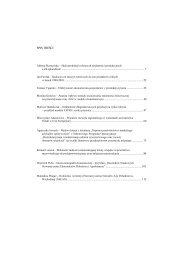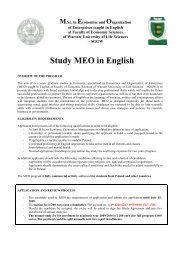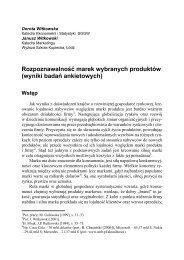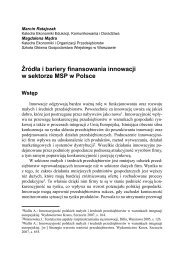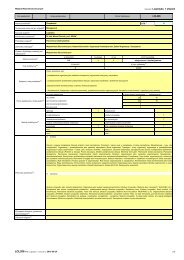pobierz - WydziaÅ Nauk Ekonomicznych SGGW w Warszawie
pobierz - WydziaÅ Nauk Ekonomicznych SGGW w Warszawie
pobierz - WydziaÅ Nauk Ekonomicznych SGGW w Warszawie
You also want an ePaper? Increase the reach of your titles
YUMPU automatically turns print PDFs into web optimized ePapers that Google loves.
The next two cases (Home Grown Cow, Locally Grown) are examples ofelectronic shopping centers (electronic malls) of agricultural products. The electronicmalls enable farmers to post information about their products. Using the electronic malls,farmers do not need to maintain and promote their own electronic stores, because all themarketing efforts, receiving of orders and enabling payments, are conducted by theelectronic mall. However farmers have to pay commissions that are percentage of salesrealized through the electronic mall.All the four presented examples of the B2C selling type show that farmers makeefforts to offer customers the value that is difficult to offer by traditional retail shops.The value can have many sources such as: easy to identify origin of products, the factthat the products are grown locally, customer choice of preferred production method,exceptional product quality (connected with taste, organic production). Most of thepresented B2C cases show that farmers using the Internet sell products for niche marketssuch as local society, customers of good knowledge on food quality, customers that lookfor unique product features.The last two cases are devoted to B2B sale of agricultural commodities. Twoelectronic marketplaces of agricultural commodities were presented (IGT electronicplatform operating in Poland, and NSEL electronic platform operating in India). Bothelectronic exchanges provide many market possibilities and functions for farmers. Theyenable farmers to find new customers and to broaden market reach. The electronic B2Bpublic marketplaces also enable to avoid intermediaries on the agricultural commoditiesmarket and contribute to the more efficient price discovery at country level. Theelectronic marketplaces are also introducing services connected with supporting supplychain activities.References1. Aikman K.: Home Grown Cow provides farmers with E-Commerce opportunities, 2011,http://www.mikeroweworks.com/2011/022. AdelaideNow, Riverland farmers are fighting back against supermarkets cutting into theirprofits by selling fruit directly to customers online, 2010,http://www.adelaidenow.com.au/news/south-australia3. Chinese farmers go online to sell products, AFP, March, 2011, http://au.news.yahoo.com4. Hoffman D., Novak T.: Marketing in Hypermedia Computer-Mediated Environment.Conceptual Foundations. Journal of Marketing. (1996), Vol. 605. Karasiewicz G. Systemy dystrybucji artykułów rolno-spożywczych na rynku polskim,Wydawnictwa <strong>Nauk</strong>owe Wydziału Zarządzania UW, Warszawa, 20016. Keh H. Shieh E.: Online Grocery Retailing: Success Factors and Potential Pitfalls.Business Horizons Vol. 44, No.4, July 20017. Mahadaven B.:, Making Sense of the Emerging Market Structure in B2B E-Commerce,California Management Review, 2003, http://www.iimb.ernet.in/~mahadev/cmrb2b.pdf8. Nicolaisen R.:How will agricultural e-markets evolve. Proceedings of the USDA OutlookForum, Washington, DC, 20019. Readaway Ch., Smith M.: Godzina Dziennie z Facebook Marketingiem. Helion Press2010,195



